Affordable Nutrient Density in Brazil: Nutrient Profiling in Relation to Food Cost and NOVA Category Assignments
Abstract
1. Introduction
2. Materials and Methods
2.1. Nutrient Composition Database
2.2. The NOVA Classification Scheme
2.3. Food Prices Adjusted for Yield and Affordability Metrics
2.4. Nutrient Density
The Nutrient Rich Food Approach
2.5. Plan of Analysis
3. Results
3.1. Distribution of Foods by Food Group and NOVA Category
3.2. NOVA Categories by Food Group
3.3. Nutrient Density Scores by Food Group
3.4. Cost by Nutrient Density and NOVA Categories
3.5. Affordable Nutrient Density: High NRF Scores at below Median Cost
4. Discussion
5. Conclusions
Author Contributions
Funding
Institutional Review Board Statement
Informed Consent Statement
Data Availability Statement
Conflicts of Interest
References
- FAO; IFAD; UNICEF; WFP; WHO. The State of Food Security and Nutrition in the World 2021: Transforming Food Systems for Food Security, Improved Nutrition and Affordable Healthy Diets for All; FAO: Rome, Italy, 2021; 240p, Available online: https://www.fao.org/documents/card/en/c/cb4474en/ (accessed on 7 March 2022).
- FAO; IFAD; UNICEF; WFP; WHO. The State of Food Security and Nutrition in the World 2020: Transforming Food Systems for Affordable Healthy Diets; FAO: Rome, Italy, 2020; 320p, Available online: https://www.fao.org/documents/card/en/c/ca9692en (accessed on 10 March 2022).
- Marshall, N.E.; Abrams, B.; Barbour, L.A.; Catalano, P.; Christian, P.; Friedman, J.E.; Hay, W.W.; Hernandez, T.L.; Krebs, N.F.; Oken, E.; et al. The importance of nutrition in pregnancy and lactation: Lifelong consequences. Am. J. Obstet. Gynecol. 2022, 226, 607–632. [Google Scholar] [CrossRef]
- Matonti, L.; Blasetti, A.; Chiarelli, F. Nutrition and growth in children. Minerva Pediatr. 2020, 72, 462–471. [Google Scholar] [CrossRef]
- Bailey, R.L.; West, K.P., Jr.; Black, R.E. The Epidemiology of Global Micronutrient Deficiencies. Ann. Nutr. Metab. 2015, 66 (Suppl. 2), 22–33. [Google Scholar] [CrossRef] [PubMed]
- Beal, T.; Ortenzi, F. Priority Micronutrient Density in Foods. Front. Nutr. 2022, 9, 806566. Available online: https://www.frontiersin.org/articles/10.3389/fnut.2022.806566 (accessed on 12 March 2022). [CrossRef]
- Wu, G.; Fanzo, J.; Miller, D.D.; Pingali, P.; Post, M.; Steiner, J.L.; Thalacker-Mercer, A.E. Production and supply of high-quality food protein for human consumption: Sustainability, challenges, and innovations. Ann. N. Y. Acad. Sci. 2014, 1321, 1–19. [Google Scholar] [CrossRef]
- Ortenzi, F.; Beal, T. Priority Micronutrient Density of Foods for Complementary Feeding of Young Children (6–23 Months) in South and Southeast Asia. Front. Nutr. 2021, 8, 785227. Available online: https://www.frontiersin.org/articles/10.3389/fnut.2021.785227 (accessed on 13 March 2022). [CrossRef] [PubMed]
- Ryckman, T.; Beal, T.; Nordhagen, S.; Chimanya, K.; Matji, J. Affordability of nutritious foods for complementary feeding in Eastern and Southern Africa. Nutr. Rev. 2021, 79 (Suppl. S1), 35–51. [Google Scholar] [CrossRef] [PubMed]
- Monteiro, C.A.; Cannon, G.; Moubarac, J.C.; Levy, R.B.; Louzada, M.L.C.; Jaime, P.C. The UN Decade of Nutrition, the NOVA food classification and the trouble with ultra-processing. Public Health Nutr. 2018, 21, 5–17. [Google Scholar] [CrossRef]
- Verly, E., Jr.; Darmon, N.; Sichieri, R.; Sarti, F.M. Reaching culturally acceptable and adequate diets at the lowest cost increment according to income level in Brazilian households. PLoS ONE 2020, 15, e0229439. [Google Scholar] [CrossRef]
- Food and Agricultural Organization (FAO). FAOSTAT Database, Food Balance Sheets; Food and Agricultural Organization: Rome, Italy, 2013; Available online: https://www.fao.org/faostat/en/#data (accessed on 25 July 2022).
- Da Louzada, M.L.C.; Ricardo, C.Z.; Steele, E.M.; Levy, R.B.; Cannon, G.; Monteiro, C.A. The share of ultra-processed foods determines the overall nutritional quality of diets in Brazil. Public Health Nutr. 2018, 21, 94–102. [Google Scholar] [CrossRef] [PubMed]
- Passos, C.M.D.; Maia, E.G.; Levy, R.B.; Martins, A.P.B.; Claro, R.M. Association between the price of ultra-processed foods and obesity in Brazil. Nutr. Metab. Cardiovasc. Dis. NMCD 2020, 30, 589–598. [Google Scholar] [CrossRef]
- Instituto Brasileiro de Geografia e Estatistica. POF—Consumer Expenditure Survey 2008–2009; Instituto Brasileiro de Geografia e Estatistica: Brasília, Brazil, 2011. Available online: https://www.ibge.gov.br/en/statistics/social/population/17387-pof-2008-2009-en.html?edicao=19562&t=resultados (accessed on 23 July 2022).
- U.S. Department of Agriculture. USDA Food and Nutrient Database for Dietary Studies 2017–2018; U.S. Department of Agriculture: Washington, DC, USA, 2018; p. 39. Available online: https://www.ars.usda.gov/ARSUserFiles/80400530/pdf/fndds/2017_2018_FNDDS_Doc.pdf (accessed on 22 April 2022).
- Siqueira, K.B.; Borges, C.A.; Binoti, M.L.; Pilati, A.F.; da Silva, P.H.; Gupta, S.; Drewnowski, A. Nutrient density and affordability of foods in Brazil by food group and degree of processing. Public Health Nutr. 2021, 24, 4564–4571. [Google Scholar] [CrossRef] [PubMed]
- Monteiro, C.A.; Cannon, G.; Levy, R.B.; Moubarac, J.-C.; Louzada, M.L.C.; Rauber, F.; Khandpur, N.; Cediel, G.; Neri, D.; Martinez-Steele, E.; et al. Ultra-processed foods: What they are and how to identify them. Public Health Nutr. 2019, 22, 936–941. [Google Scholar] [CrossRef] [PubMed]
- Dos Costa, C.S.; de Faria, F.R.; Gabe, K.T.; Sattamini, I.F.; Khandpur, N.; Leite, F.H.M.; Steele, E.M.; da Costa Louzada, M.L.; Levy, R.B.; Monteiro, C.A. Nova score for the consumption of ultra-processed foods: Description and performance evaluation in Brazil. Rev. Saúde Pública 2021, 55, 13. [Google Scholar]
- Stewart, H.; Hyman, J.; Buzby, J.C.; Frazão, E.; Carlson, A. How Much do Fruits and Vegetables Cost? U.S. Department of Agriculture: Washington, DC, USA, 2011. Available online: http://www.ers.usda.gov/publications/pub-details/?pubid=44520 (accessed on 25 July 2022).
- Instituto Brasileiro de Geografia e Estatistica. POF—Pesquisa de Orçamentos Familiares. Available online: https://www.ibge.gov.br/estatisticas/sociais/populacao/24786-pesquisa-de-orcamentos-familiares-2.html?edicao=32323&t=downloads (accessed on 23 July 2022).
- Extended National Consumer Price Index|IBGE. Available online: https://www.ibge.gov.br/en/statistics/economic/prices-and-costs/17129-extended-national-consumer-price-index.html?=&t=o-que-e (accessed on 5 April 2022).
- Herforth, A.; Bai, Y.; Venkat, A.; Mahrt, K.; Ebel, A.; Masters, W.A. Cost and Affordability of Healthy Diets across and within Countries: Background Paper for The State of Food Security and Nutrition in the World 2020; FAO Agricultural Development Economics Technical Study No. 9; FAO: Rome, Italy, 2020; 108p, Available online: https://www.fao.org/documents/card/en/c/cb2431en (accessed on 19 February 2022).
- Drewnowski, A. The Nutrient Rich Foods Index helps to identify healthy, affordable foods. Am. J. Clin. Nutr. 2010, 91, 1095S–1101S. [Google Scholar] [CrossRef]
- Fulgoni, V.L.; Keast, D.R.; Drewnowski, A. Development and validation of the nutrient-rich foods index: A tool to measure nutritional quality of foods. J. Nutr. 2009, 139, 1549–1554. [Google Scholar] [CrossRef] [PubMed]
- Ministry of Health of Brazil. Dietary Guidelines for the Brazilian Population; Secretariat of Health Care: Brasilia, Brazil, 2015; p. 152. Available online: https://bvsms.saude.gov.br/bvs/publicacoes/dietary_guidelines_brazilian_population.pdf (accessed on 9 May 2022).
- Lewis, J. Codex Nutrient Reference Values; FAO: Rome, Italy; WHO: Rome, Italy, 2019; Available online: https://www.fao.org/3/ca6969en/CA6969EN.pdf (accessed on 30 April 2022).
- Fisberg, R.M.; Marchioni, D.M.L.; de Castro, M.A.; Verly, E.; Araújo, M.C.; Bezerra, I.N.; Pereira, R.A.; Sichieri, R. Inadequate nutrient intake among the Brazilian elderly: National Dietary Survey 2008–2009. Rev. Saude Publica 2013, 47 (Suppl. S1), 222S–230S. [Google Scholar] [CrossRef] [PubMed]
- Hess, J.M.; Slavin, J.L. Healthy Snacks: Using Nutrient Profiling to Evaluate the Nutrient-Density of Common Snacks in the United States. J. Food Sci. 2017, 82, 2213–2220. [Google Scholar] [CrossRef] [PubMed]
- Gupta, S.; Rose, C.M.; Buszkiewicz, J.; Otten, J.; Spiker, M.L.; Drewnowski, A. Inedible Food Waste Linked to Diet Quality and Food Spending in the Seattle Obesity Study SOS III. Nutrients 2021, 13, 479. [Google Scholar] [CrossRef] [PubMed]
- Dikmen, D.; Kızıl, M.; Uyar, M.F.; Pekcan, G. Testing Two Nutrient Profiling Models of Labelled Foods and Beverages Marketed in Turkey. Cent. Eur. J. Public Health 2015, 23, 155–160. [Google Scholar] [CrossRef] [PubMed]
- Barr, S.I.; Vatanparast, H.; Smith, J. Breakfast in Canada: Prevalence of Consumption, Contribution to Nutrient and Food Group Intakes, and Variability across Tertiles of Daily Diet Quality. A Study from the International Breakfast Research Initiative. Nutrients 2018, 10, E985. [Google Scholar] [PubMed]
- Beal, T.; Massiot, E.; Arsenault, J.E.; Smith, M.R.; Hijmans, R.J. Global trends in dietary micronutrient supplies and estimated prevalence of inadequate intakes. PLoS ONE 2017, 12, e0175554. [Google Scholar] [CrossRef] [PubMed]
- White, J.M.; Beal, T.; Arsenault, J.E.; Okronipa, H.; Hinnouho, G.M.; Chimanya, K.; Matji, J.; Garg, A. Micronutrient gaps during the complementary feeding period in 6 countries in Eastern and Southern Africa: A Comprehensive Nutrient Gap Assessment. Nutr. Rev. 2021, 79 (Suppl. S1), 16–25. [Google Scholar] [CrossRef] [PubMed]
- Curi-Quinto, K.; Unar-Munguía, M.; Rodríguez-Ramírez, S.; Rivera, J.A.; Fanzo, J.; Willett, W.; Röös, E. Sustainability of Diets in Mexico: Diet Quality, Environmental Footprint, Diet Cost, and Sociodemographic Factors. Front. Nutr. 2022, 9, 855793. Available online: https://www.frontiersin.org/articles/10.3389/fnut.2022.855793 (accessed on 1 May 2022). [CrossRef]
- Darmon, N.; Darmon, M.; Maillot, M.; Drewnowski, A. A nutrient density standard for vegetables and fruits: Nutrients per calorie and nutrients per unit cost. J. Am. Diet. Assoc. 2005, 105, 1881–1887. [Google Scholar] [CrossRef]
- Hallinan, S.; Rose, C.; Buszkiewicz, J.; Drewnowski, A. Some Ultra-Processed Foods Are Needed for Nutrient Adequate Diets: Linear Programming Analyses of the Seattle Obesity Study. Nutrients 2021, 13, 3838. [Google Scholar] [CrossRef] [PubMed]
- Starck, C.; Blumfield, M.; Keighley, T.; Marshall, S.; Petocz, P.; Inan-Eroglu, E.; Abbott, K.; Cassettari, T.; Ali, A.; Wham, C.; et al. Nutrient Dense, Low-Cost Foods Can Improve the Affordability and Quality of the New Zealand Diet-A Substitution Modeling Study. Int. J. Environ. Res. Public Health 2021, 18, 7950. [Google Scholar] [CrossRef]
- Capozzi, F. Food Innovation in the Frame of Circular Economy by Designing Ultra-Processed Foods Optimized for Sustainable Nutrition. Front. Nutr. 2022, 9, 886220. [Google Scholar] [CrossRef]
- Pan American Health Organization. Ultra-Processed Food and Drink Products in Latin America: Trends, Impact on Obesity, Policy Implications. Alimentos y Bebidas Ultraprocesados en América Latina: Tendencias, Efecto Sobre la Obesidad e Implicaciones para las Políticas Públicas. 2015. Available online: https://iris.paho.org/handle/10665.2/7699 (accessed on 9 March 2022).
- Martínez Steele, E.; Baraldi, L.G.; da Louzada, M.L.C.; Moubarac, J.C.; Mozaffarian, D.; Monteiro, C.A. Ultra-processed foods and added sugars in the US diet: Evidence from a nationally representative cross-sectional study. BMJ Open 2016, 6, e009892. [Google Scholar] [CrossRef] [PubMed]
- Processed Foods and Health. The Nutrition Source; Harvard: Boston, MA, USA, 2019; Available online: https://www.hsph.harvard.edu/nutritionsource/processed-foods/ (accessed on 9 March 2022).
- Mendoza, A.; Pérez, A.E.; Aggarwal, A.; Drewnowski, A. Energy density of foods and diets in Mexico and their monetary cost by socioeconomic strata: Analyses of ENSANUT data 2012. J. Epidemiol. Community Health 2017, 71, 713–721. [Google Scholar] [CrossRef]
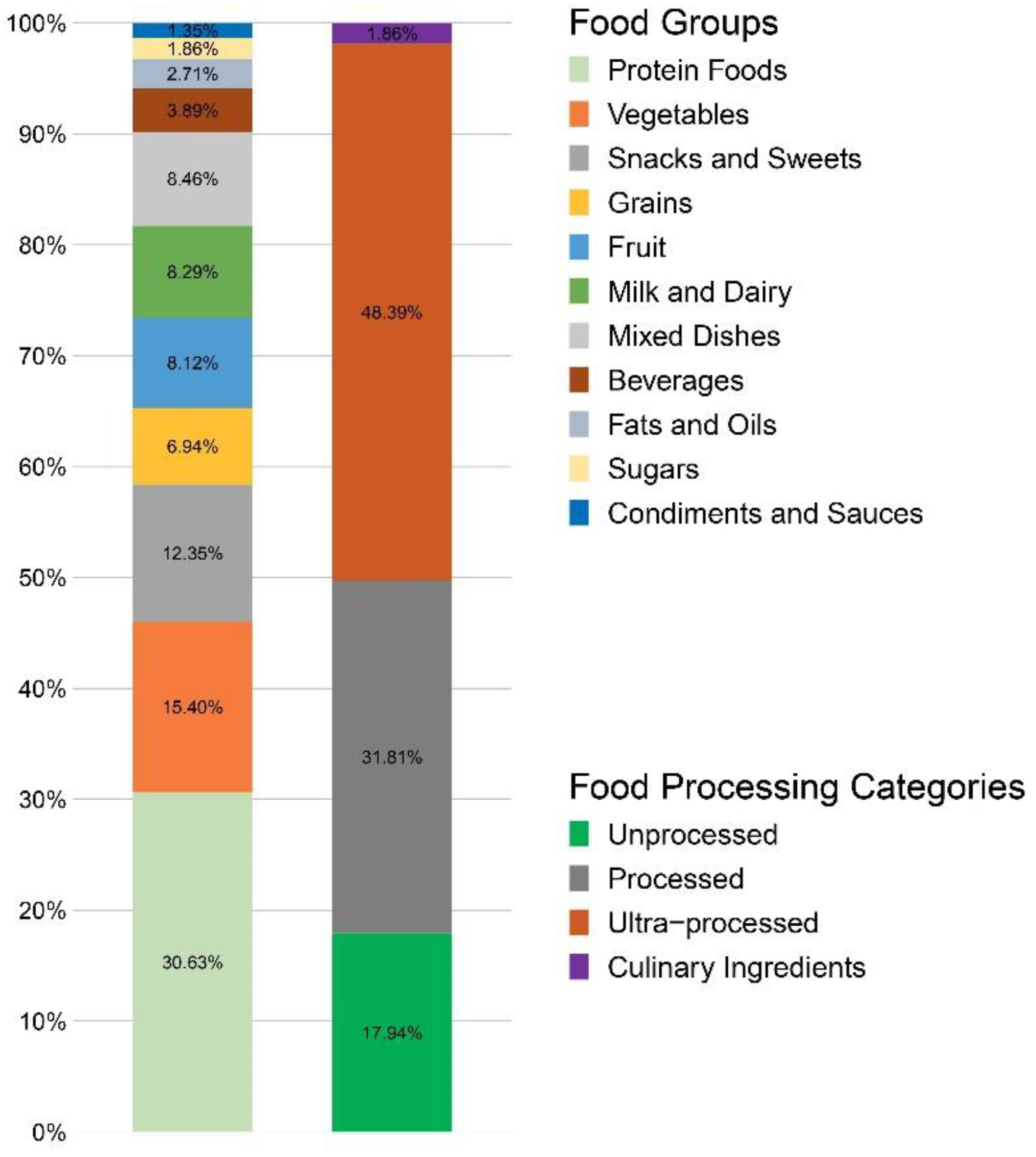
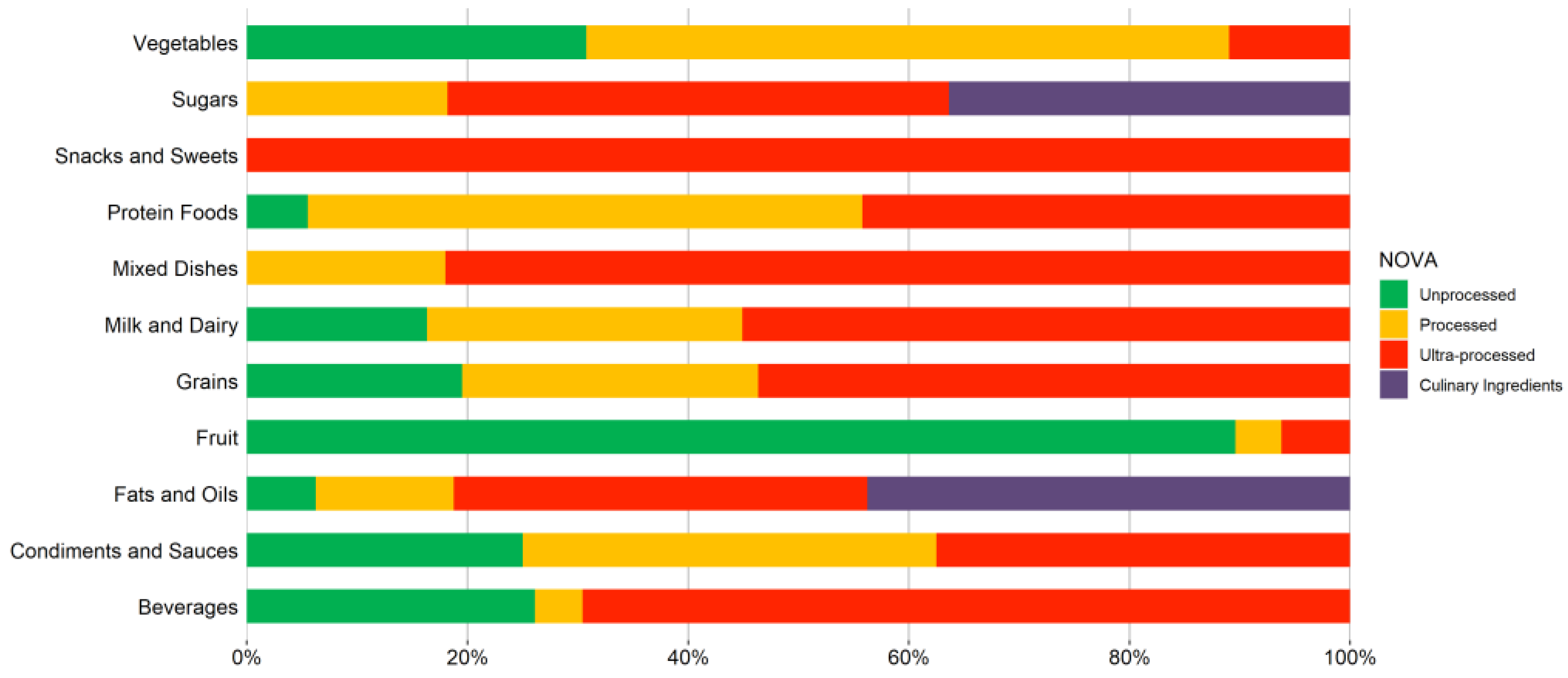
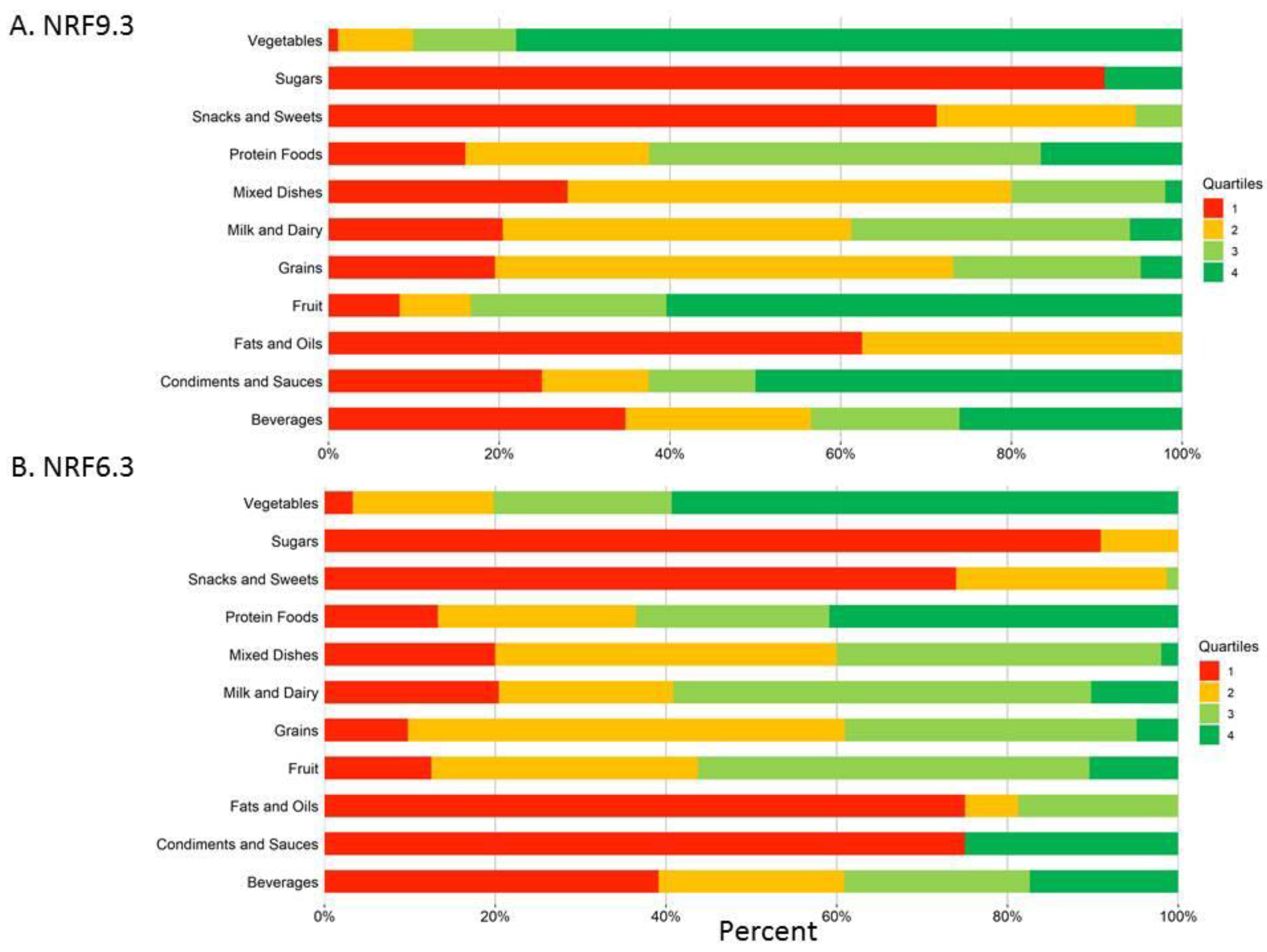
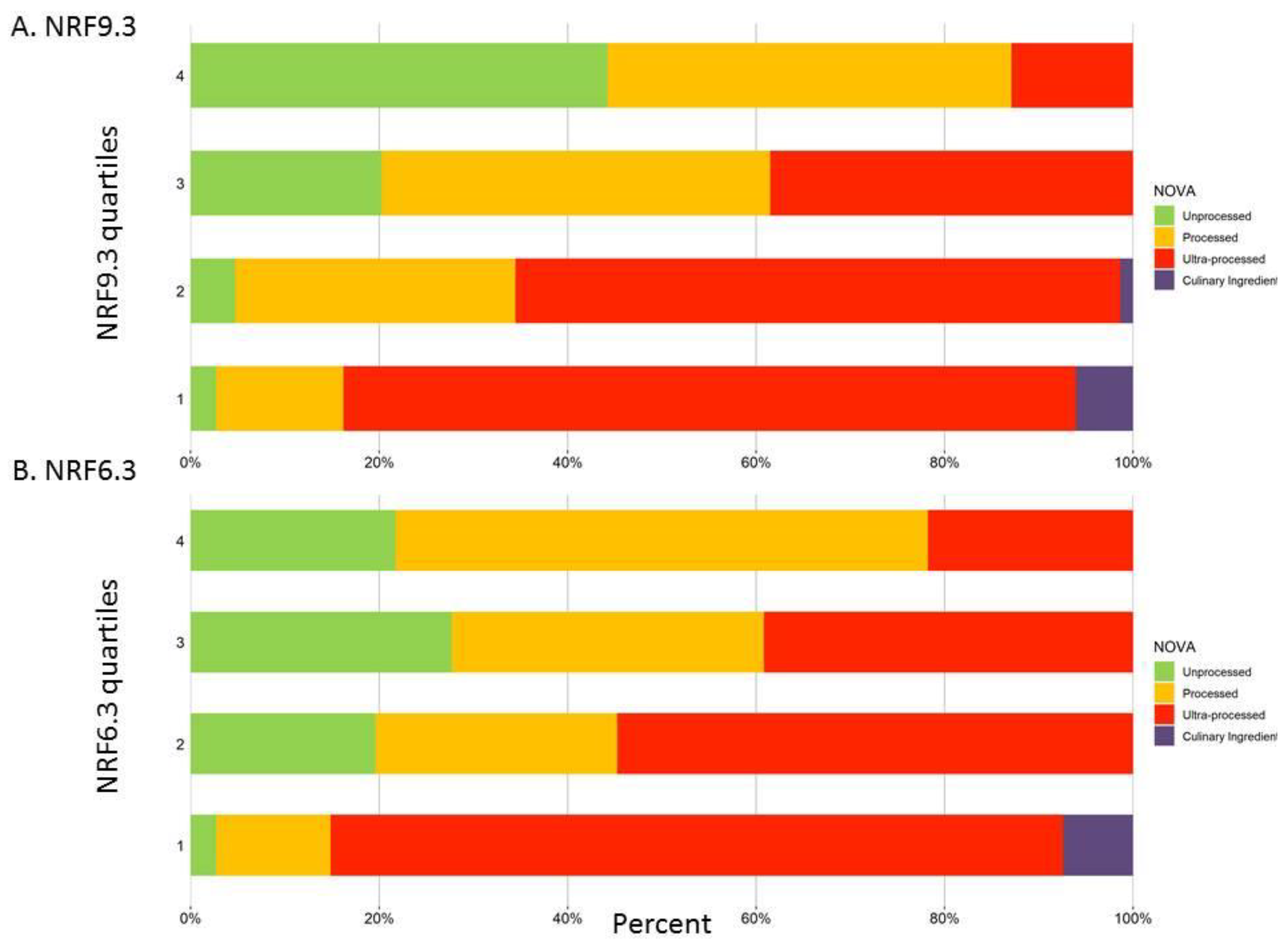
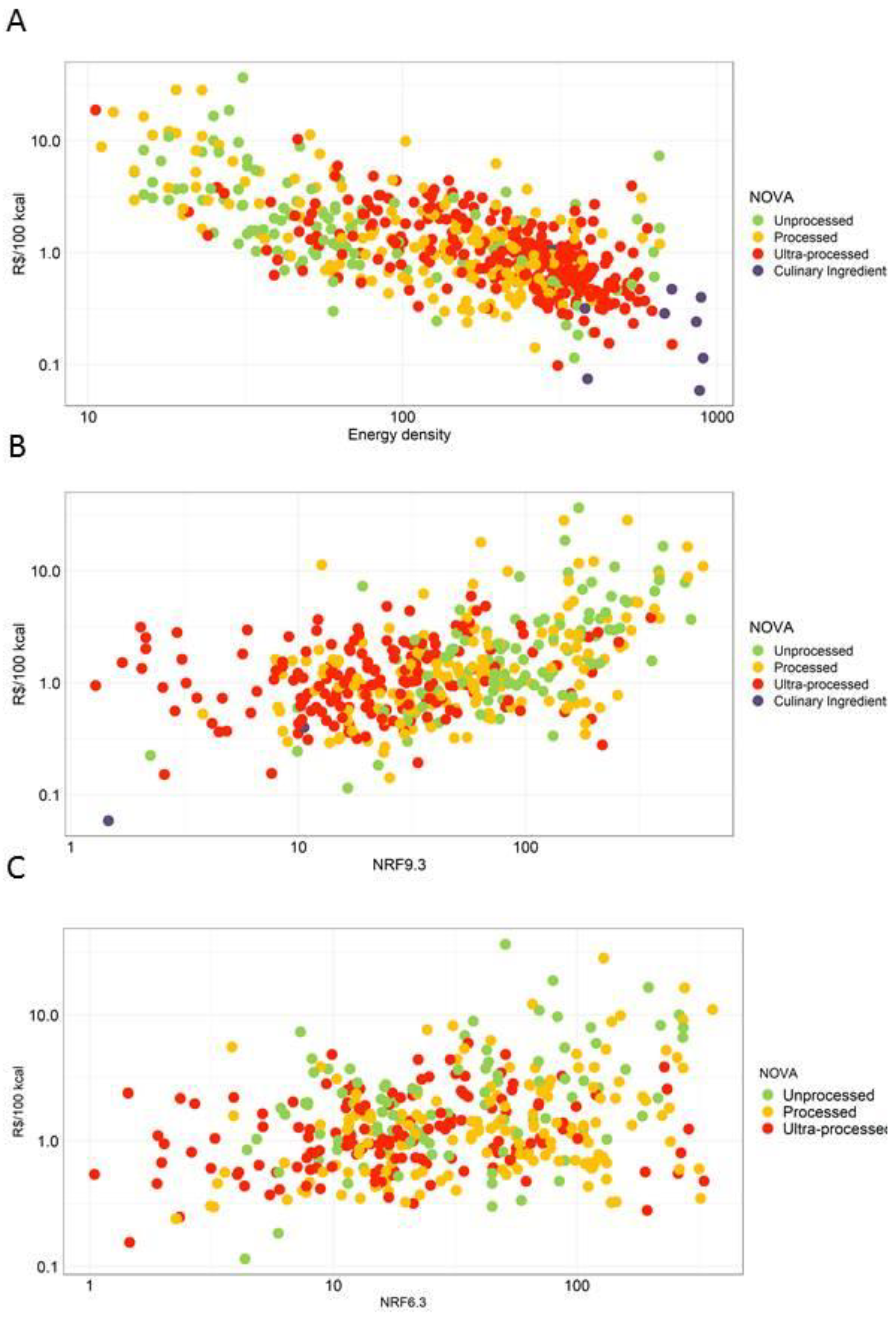
| Food Items | NR6 | NR9 | LIM | LIMt | ||||
|---|---|---|---|---|---|---|---|---|
| n | Mean (SD) | n | Mean (SD) | n | Mean (SD) | n | Mean (SD) | |
| All items | 591 | 51.3 (61.4) | 591 | 73.9 (87.8) | 591 | 19.9 (18.4) | 589 | 20.7 (16.4) |
| NOVA categories | ||||||||
| Minimally processed | 106 | 53.6 (65.5) | 106 | 127.0 (108.6) | 106 | 6.9 (14.1) | 104 | 17.1 (14.4) |
| Processed | 188 | 76.9 (70.9) | 188 | 98.5 (103.9) | 188 | 18.0 (21.7) | 188 | 20.1 (22.3) |
| Ultra-Processed | 286 | 35.4 (46.3) | 286 | 40.4 (42.5) | 286 | 25.4 (14.4) | 286 | 22.3 (11.9) |
| Culinary ingredients | 11 | 5.4 (6.8) | 11 | 10.3 (9.7) | 11 | 34.7 (17.2) | 11 | 26.0 (12.5) |
| p-Value * | <0.0001 | <0.0001 | <0.0001 | <0.0279 | ||||
| Price (R$) | |||||||
|---|---|---|---|---|---|---|---|
| Food Items | Energy Density kcal/100 g | Saturated Fat g | Total Sugar g | Added Sugar g | Per 100 g | 100 kcal | |
| N | Mean (SE) | Mean (SE) | Mean (SE) | Mean (SE) | Mean (SE) | Mean (SE) | |
| All items | 591 | 208.7 (6.6) | 3.7 (0.3) | 9.4 (0.7) | 6.9 (0.7) | 2.3 (0.1) | 1.9 (0.13) |
| NOVA categories | |||||||
| Minimally processed | 106 | 127.1 (14.9) | 1.5 (0.4) | 6.5 (0.9) | 0.01 (0.0) | 2.3 (0.5) | 3.1 (0.4) |
| Processed | 188 | 160.3 (8.7) | 3.1 (0.3) | 2.2 (0.5) | 0.9 (0.5) | 2.1 (0.2) | 2.4 (0.3) |
| Ultra-processed | 286 | 255.5 (8.4) | 4.2 (0.3) | 14.4 (1.2) | 12.7 (1.2) | 2.4 (0.1) | 1.3 (0.1) |
| Culinary ingredients | 11 | 603.5 (78.4) | 23.1 (7.8) | 29.2 (13.0) | 31.0 (13.3) | 2.1 (0.4) | 0.5 (0.1) |
| p-Value * | <0.0001 | <0.0001 | <0.0001 | <0.0001 | <0.7923 | <0.0001 | |
| Affordability | |||||||||
|---|---|---|---|---|---|---|---|---|---|
| No | IBGE Food ID | Food | Energy Density | $R/100 kcal | NRF9.3 | NRF6.3 | NRF9.3 | NRF6.3 | NOVA |
| 1 | 6700301 | Kale, cooked from fresh, boiled, salt used | 58.9 | 0.78 | 253.5 | 122.9 | 32.6 | 15.8 | PF |
| 2 | 6906501 | Fortified diet shake, meal replacement, dry powders (not reconstituted) | 335.5 | 0.28 | 216.8 | 193.8 | 27.9 | 24.9 | UPF |
| 3 | 7104601 | Pork, organ meats, liver, stewed or boiled, salt added | 165.0 | 0.60 | 211.7 | 316.9 | 27.2 | 40.8 | PF |
| 4 | 7801001 | Chicken, liver, stewed or boiled, salt added (80 g) + industrial sauce, tomato, regular (20 g) | 138.4 | 0.48 | 194.3 | 332.1 | 25.0 | 42.7 | UPF |
| 5 | 6400401 | Sweet potato, baked, salt added | 90.0 | 0.43 | 183.2 | 111.2 | 23.6 | 14.3 | PF |
| 6 | 6400501 | Yams (sweet potato), baked, salt added | 90.0 | 0.67 | 183.2 | 111.2 | 23.6 | 14.3 | PF |
| 7 | 7801001 | Chicken, liver, fried | 189.7 | 0.35 | 182.5 | 321.4 | 23.5 | 41.4 | PF |
| 8 | 6400304 | Sweet potato, boiled, salt added | 76.0 | 0.97 | 172.3 | 111.2 | 22.2 | 14.3 | PF |
| 9 | 6401201 | Carrots, cooked from fresh, fried or sauteed, fat used | 60.5 | 0.65 | 167.0 | 107.9 | 21.5 | 13.9 | PF |
| 10 | 6801801 | Orange, fresh | 47.0 | 0.76 | 160.2 | 29.8 | 20.6 | 3.8 | MPF |
| 11 | 6401201 | Carrots, cooked from fresh, stir-fried, butter used, regular, salt added | 56.7 | 0.70 | 158.2 | 98.2 | 20.4 | 12.6 | PF |
| 12 | 7102501 | Beef, liver, stewed or boiled, no salt added (80 g) + industrial sauce, tomato, regular (20 g) | 157.6 | 0.80 | 157.9 | 267.1 | 20.3 | 34.4 | UPF |
| 13 | 6400501 | Yams (sweet potato type), cooked from frozen, salt added | 100.0 | 0.60 | 152.8 | 114.2 | 19.7 | 14.7 | PF |
| 14 | 7102501 | Beef, liver, stir-fried, fat used, salt added | 213.7 | 0.59 | 150.4 | 262.7 | 19.3 | 33.8 | PF |
| 15 | 7102501 | Beef, liver, fried, breaded or batter dipped | 229.8 | 0.55 | 148.2 | 259.9 | 19.1 | 33.4 | UPF |
| 16 | 6804901 | Elderberries, fresh | 73.0 | 0.78 | 145.3 | 25.4 | 18.7 | 3.3 | MPF |
| 17 | 6501301 | Cereal, ready-to-eat, wheat germ | 360.0 | 0.34 | 131.8 | 59.0 | 17.0 | 7.6 | UPF |
| 18 | 6400908 | Sweet potato, boiled, fat used, salt added | 116.4 | 0.69 | 126.5 | 84.2 | 16.3 | 10.8 | PF |
| 19 | 6802602 | Pineapple, fresh | 48.0 | 0.84 | 119.1 | 16.2 | 15.3 | 2.1 | MPF |
| 20 | 6802202 | Tangerine, fresh | 53.0 | 0.95 | 109.1 | 24.8 | 14.0 | 3.2 | MPF |
| 21 | 7264101 | Oyster, cooked from fresh or frozen, stewed, or boiled, salt added | 137.0 | 0.98 | 106.5 | 241.6 | 13.7 | 31.1 | PF |
| 22 | 7903601 | Milk, skim, no fat or fat-free | 34.2 | 1.03 | 96.4 | 132.6 | 12.4 | 17.1 | MPF |
| 23 | 7273101 | Fish and seafood, roe, herring, stewed or boiled, salt added | 204.0 | 0.68 | 95.5 | 118.6 | 12.3 | 15.3 | PF |
| 24 | 8104001 | Pate, pork liver | 326.0 | 0.56 | 94.6 | 190.6 | 12.2 | 24.5 | UPF |
| 25 | 6401101 | Beets, raw | 43.0 | 0.95 | 91.2 | 75.9 | 11.7 | 9.8 | MPF |
| 26 | 7273101 | Fish and seafood, roe, herring, fried, salt added | 226.7 | 0.61 | 86.1 | 115.8 | 11.1 | 14.9 | PF |
| 27 | 6301204 | Beans, fava, cooked from fresh, salt added | 85.6 | 1.01 | 85.1 | 30.9 | 11.0 | 4.0 | PF |
| 28 | 6502101 | Nestum 3 RTE cereal Nestlé | 345.8 | 0.70 | 84.0 | 53.0 | 10.8 | 6.8 | UPF |
| 29 | 6806001 | Sapoti (Tropical fruit) | 96.0 | 0.98 | 83.7 | 20.7 | 10.8 | 2.7 | MPF |
| 30 | 6900818 | Cocoa or hot chocolate, Ovaltine hot cocoa—dry mix | 388.0 | 0.61 | 81.6 | 45.2 | 10.5 | 5.8 | UPF |
Publisher’s Note: MDPI stays neutral with regard to jurisdictional claims in published maps and institutional affiliations. |
© 2022 by the authors. Licensee MDPI, Basel, Switzerland. This article is an open access article distributed under the terms and conditions of the Creative Commons Attribution (CC BY) license (https://creativecommons.org/licenses/by/4.0/).
Share and Cite
Mendoza-Velázquez, A.; Lara-Arévalo, J.; Siqueira, K.B.; Guzmán-Rodríguez, M.; Drewnowski, A. Affordable Nutrient Density in Brazil: Nutrient Profiling in Relation to Food Cost and NOVA Category Assignments. Nutrients 2022, 14, 4256. https://doi.org/10.3390/nu14204256
Mendoza-Velázquez A, Lara-Arévalo J, Siqueira KB, Guzmán-Rodríguez M, Drewnowski A. Affordable Nutrient Density in Brazil: Nutrient Profiling in Relation to Food Cost and NOVA Category Assignments. Nutrients. 2022; 14(20):4256. https://doi.org/10.3390/nu14204256
Chicago/Turabian StyleMendoza-Velázquez, Alfonso, Jonathan Lara-Arévalo, Kennya Beatriz Siqueira, Mariano Guzmán-Rodríguez, and Adam Drewnowski. 2022. "Affordable Nutrient Density in Brazil: Nutrient Profiling in Relation to Food Cost and NOVA Category Assignments" Nutrients 14, no. 20: 4256. https://doi.org/10.3390/nu14204256
APA StyleMendoza-Velázquez, A., Lara-Arévalo, J., Siqueira, K. B., Guzmán-Rodríguez, M., & Drewnowski, A. (2022). Affordable Nutrient Density in Brazil: Nutrient Profiling in Relation to Food Cost and NOVA Category Assignments. Nutrients, 14(20), 4256. https://doi.org/10.3390/nu14204256









